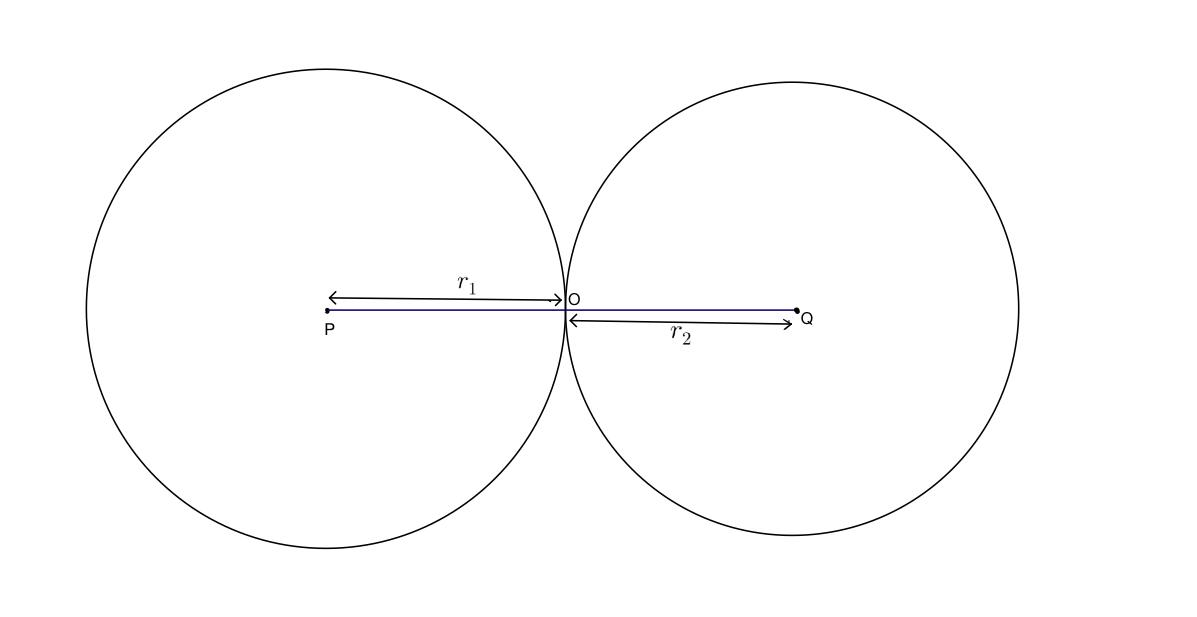Answer
415.8k+ views
Hint: In this question it is given that two circle $x^{2}+y^{2}+2ax+c=0$ and $x^{2}+y^{2}+2by+c=0$ touches each other, we have to find the relation between a,b and c. So first of all we draw the diagram.

So for finding the solution we need to find the coordinates of the centres of the circles and their radius,and from the diagram we can write the distance between the centres is equal to the summation of their radius,i.e, $r_{1}+r_{2}$=PQ.
Complete step-by-step solution:
Consider the circle $x^{2}+y^{2}+2ax+c=0$ whose centre is P and radius is $r_{1}$ and and another circle $x^{2}+y^{2}+2by+c=0$ with centre Q and radius $r_{2}$.
Now as we know that if any equation of circle is in the form of $x^{2}+y^{2}+2gx+2fy+c=0$.......(1)
Then the coordinate of the centre is (-g,-f) and radius is $\sqrt{g^{2}+f^{2}-c}$.
Now by equation (1) we can say that the centre of circle $x^{2}+y^{2}+2ax+c=0$ is P(-a,0) and radius is $r_{1}=\sqrt{\left( -a\right)^{2} +0^{2}-c} =\sqrt{a^{2}-c}$.
Similarly, the coordinate of centre and the radius of the circle $x^{2}+y^{2}+2by+c=0$ is Q(0,-b) and $r_{2}=\sqrt{b^{2}-c}$.
Now To find the distance PQ, we have to know the distance formula i.e, the distance between the points (a,b) to (c,d) is $\mathbf{d} =\sqrt{\left( a-c\right)^{2} +\left( b-d\right)^{2} }$ ............equation(2)
Now by equation (2) we can write,
PQ=$\sqrt{\left( -a-0\right)^{2} +\left( 0-\left( -b\right) \right)^{2} }$
=$\sqrt{a^{2}+b^{2}}$.
Since, as we know that the distance between the centres is equal to the summation of their radius, so we can write,
$r_{1}+r_{2}$=PQ
$$\Rightarrow \sqrt{a^{2}-c} +\sqrt{b^{2}-c} =\sqrt{a^{2}+b^{2}}$$
By squaring both side, we get,
$$\left( \sqrt{a^{2}-c} +\sqrt{b^{2}-c} \right)^{2} =\left( \sqrt{a^{2}+b^{2}} \right)^{2} $$
$$\Rightarrow \left( \sqrt{a^{2}-c} \right)^{2} +2\sqrt{a^{2}-c} \sqrt{b^{2}-c} +\left( \sqrt{b^{2}-c} \right)^{2} =a^{2}+b^{2}$$
$$\Rightarrow a^{2}-c+2\sqrt{a^{2}-c} \sqrt{b^{2}-c} +b^{2}-c=a^{2}+b^{2}$$
$$\Rightarrow 2\sqrt{a^{2}-c} \sqrt{b^{2}-c} -2c=0$$ [canceling $a^{2}$ and $b^{2}$]
$$\Rightarrow \sqrt{a^{2}-c} \sqrt{b^{2}-c} =c$$
Again squaring both side of the above equation,
$$\left( \sqrt{a^{2}-c} \sqrt{b^{2}-c} \right)^{2} =c^{2}$$
$$\Rightarrow \left( a^{2}-c\right) \left( b^{2}-c\right) =c^{2}$$
$$\Rightarrow a^{2}b^{2}-a^{2}c-b^{2}c+c^{2}=c^{2}$$
$$\Rightarrow a^{2}b^{2}-a^{2}c-b^{2}c=0$$
$$\Rightarrow a^{2}c+b^{2}c=a^{2}b^{2}$$
Now dividing both side of the above equation by $a^{2}b^{2}c$ we get,
$$\dfrac{1}{b^{2}} +\dfrac{1}{a^{2}} =\dfrac{1}{c}$$
$$\Rightarrow \dfrac{1}{a^{2}} +\dfrac{1}{b^{2}} =\dfrac{1}{c}$$
Which is our required condition.
Thus the correct option is option A.
Note: To solve this type of question you need to know that whenever two circles touch each other, then the distance between their centre is equal to the summation of their radius.

So for finding the solution we need to find the coordinates of the centres of the circles and their radius,and from the diagram we can write the distance between the centres is equal to the summation of their radius,i.e, $r_{1}+r_{2}$=PQ.
Complete step-by-step solution:
Consider the circle $x^{2}+y^{2}+2ax+c=0$ whose centre is P and radius is $r_{1}$ and and another circle $x^{2}+y^{2}+2by+c=0$ with centre Q and radius $r_{2}$.
Now as we know that if any equation of circle is in the form of $x^{2}+y^{2}+2gx+2fy+c=0$.......(1)
Then the coordinate of the centre is (-g,-f) and radius is $\sqrt{g^{2}+f^{2}-c}$.
Now by equation (1) we can say that the centre of circle $x^{2}+y^{2}+2ax+c=0$ is P(-a,0) and radius is $r_{1}=\sqrt{\left( -a\right)^{2} +0^{2}-c} =\sqrt{a^{2}-c}$.
Similarly, the coordinate of centre and the radius of the circle $x^{2}+y^{2}+2by+c=0$ is Q(0,-b) and $r_{2}=\sqrt{b^{2}-c}$.
Now To find the distance PQ, we have to know the distance formula i.e, the distance between the points (a,b) to (c,d) is $\mathbf{d} =\sqrt{\left( a-c\right)^{2} +\left( b-d\right)^{2} }$ ............equation(2)
Now by equation (2) we can write,
PQ=$\sqrt{\left( -a-0\right)^{2} +\left( 0-\left( -b\right) \right)^{2} }$
=$\sqrt{a^{2}+b^{2}}$.
Since, as we know that the distance between the centres is equal to the summation of their radius, so we can write,
$r_{1}+r_{2}$=PQ
$$\Rightarrow \sqrt{a^{2}-c} +\sqrt{b^{2}-c} =\sqrt{a^{2}+b^{2}}$$
By squaring both side, we get,
$$\left( \sqrt{a^{2}-c} +\sqrt{b^{2}-c} \right)^{2} =\left( \sqrt{a^{2}+b^{2}} \right)^{2} $$
$$\Rightarrow \left( \sqrt{a^{2}-c} \right)^{2} +2\sqrt{a^{2}-c} \sqrt{b^{2}-c} +\left( \sqrt{b^{2}-c} \right)^{2} =a^{2}+b^{2}$$
$$\Rightarrow a^{2}-c+2\sqrt{a^{2}-c} \sqrt{b^{2}-c} +b^{2}-c=a^{2}+b^{2}$$
$$\Rightarrow 2\sqrt{a^{2}-c} \sqrt{b^{2}-c} -2c=0$$ [canceling $a^{2}$ and $b^{2}$]
$$\Rightarrow \sqrt{a^{2}-c} \sqrt{b^{2}-c} =c$$
Again squaring both side of the above equation,
$$\left( \sqrt{a^{2}-c} \sqrt{b^{2}-c} \right)^{2} =c^{2}$$
$$\Rightarrow \left( a^{2}-c\right) \left( b^{2}-c\right) =c^{2}$$
$$\Rightarrow a^{2}b^{2}-a^{2}c-b^{2}c+c^{2}=c^{2}$$
$$\Rightarrow a^{2}b^{2}-a^{2}c-b^{2}c=0$$
$$\Rightarrow a^{2}c+b^{2}c=a^{2}b^{2}$$
Now dividing both side of the above equation by $a^{2}b^{2}c$ we get,
$$\dfrac{1}{b^{2}} +\dfrac{1}{a^{2}} =\dfrac{1}{c}$$
$$\Rightarrow \dfrac{1}{a^{2}} +\dfrac{1}{b^{2}} =\dfrac{1}{c}$$
Which is our required condition.
Thus the correct option is option A.
Note: To solve this type of question you need to know that whenever two circles touch each other, then the distance between their centre is equal to the summation of their radius.
Recently Updated Pages
Assertion The resistivity of a semiconductor increases class 13 physics CBSE

The Equation xxx + 2 is Satisfied when x is Equal to Class 10 Maths

How do you arrange NH4 + BF3 H2O C2H2 in increasing class 11 chemistry CBSE

Is H mCT and q mCT the same thing If so which is more class 11 chemistry CBSE

What are the possible quantum number for the last outermost class 11 chemistry CBSE

Is C2 paramagnetic or diamagnetic class 11 chemistry CBSE

Trending doubts
Difference between Prokaryotic cell and Eukaryotic class 11 biology CBSE

Difference Between Plant Cell and Animal Cell

Fill the blanks with the suitable prepositions 1 The class 9 english CBSE

Change the following sentences into negative and interrogative class 10 english CBSE

Give 10 examples for herbs , shrubs , climbers , creepers

What organs are located on the left side of your body class 11 biology CBSE

Write an application to the principal requesting five class 10 english CBSE

What is the type of food and mode of feeding of the class 11 biology CBSE

Name 10 Living and Non living things class 9 biology CBSE



